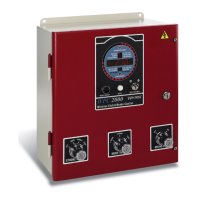WPC 2000 User Manual 1128500
Initialization, Setup, and Checkout 3-15
2. Turn power on to the WPC 2000, and observe the current crankshaft angle shown in the
LED display.
3. Run the press in Continuous mode by turning the Mode Select switch to “CONT,” select
the “Angle/SPM” indicator segment, using the Reset/Select button, and check the press
speed shown in the LED display.
If your press does not run in Continuous, initiate a stroke with the Mode Select switch set
to “SINGLE.”
4. When the press reaches normal operating speed in Continuous or the Auto Carry-up Angle
is passed in Single-stroke, Top-stop the press.
5. Press the Reset/Select button repeatedly until the “Stopping Time” indicator becomes lit.
6. Observe the reading in the LED display. This is the Stopping Time of your press in
milliseconds.
7. Run this test at least five more times, recording the highest test reading. This is the
Stopping Time value you use to set the Stop-time Limit.
Calculating the Stop-time Limit
Once you know the actual Stopping Time of your press at Top-stop, you can calculate the
Stop-time Limit, the setting WPC 2000 uses to determine when to alert the operator to the
need for brake service. The Stop-time Limit is calculated by adding a percentage factor,
abbreviated “Tbm” (i.e., Time, brake monitor), to the Stopping Time.
stop-time limit = stopping time + Tbm
The Tbm value represents normal wear on the brake and ensures that WPC 2000 does not stop
the press for small increases in Stopping Time. The minimum value that you can set is 10 mS.
Stop-time Limit Calculation Examples
Example 1: Your recorded stopping time is 207 mS and your brake is old:
Take 10% of 207 (0.10 x 207 = 20.7; round it up to 21)
Add 21 to 207 (207 + 21 = 228)
228 mS is the calculated stop-time limit.
Example 2: Your recorded stopping time is 175 mS and your brake is new:
Take 20% of 175 (0.20 x 175 = 35)
Add 35 to 175 (175 + 35 = 210)
210 mS is the calculated stop-time limit.
STOP-TIME LIMIT ADJUSTMENT: ADD 10% FOR OLD BRAKES, 20% FOR NEW BRAKES
The rule of thumb for calculating the Stop-time Limit is to add 20% to the Stopping Time of your
press if your brakes are new, 10% if your brakes are old. The reasoning is that since Stopping
Time should be shorter with new brakes, the 20% value should yield roughly the same Stop-time
Limit for new brakes as the 10% value yields for old brakes.

